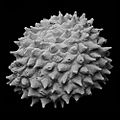Acritarch facts for kids
Acritarchs are tiny, ancient fossils. They are thought to be the remains of early eukaryote cells. Eukaryotes are living things whose cells have a nucleus, like plants, animals, and fungi.
What we see of acritarchs are their tough outer walls. These walls were probably made of a special organic material. They are found in very old rocks from the Proterozoic era. Scientists think these fossils might be like the resting stages of modern dinoflagellates. Dinoflagellates are tiny ocean creatures that can cause "red tides."
Acritarchs started appearing in large numbers in certain rocks. These rocks are rich in organic material and are about 1.4 to 1.6 billion years old. There are many different shapes of acritarchs. So, it's not clear if they all came from one single ancestor.
Around 1 billion years ago, acritarchs became more common and diverse. They also grew larger and developed more spines. Their numbers dropped during the Cryogenian period, about 860 million years ago. This was a time when Earth experienced "Snowball Earth" events, meaning much of the planet was covered in ice.
After this icy period, acritarchs grew rapidly during the Cambrian explosion. This was a time when many new types of life appeared. They reached their highest diversity in the Paleozoic era. Acritarchs survived at least until the Ordovician period.
Why Spines?
The increase in spines on acritarchs might have been a way to protect themselves. These spines could have made it harder for larger predators to eat them or break them apart. Other small organisms from the Neoproterozoic era also show signs of having ways to defend themselves against predators.
New Discoveries
A recent discovery has taught us a lot more about acritarchs. Large acritarchs, about 50 micrometers in size, were found in silica-rich rocks in South Africa. These rocks are from the Archaean age, dating back 3.2 billion years. This makes them the second oldest life forms found as fossils. The oldest known life forms are cyanobacteria, found in structures called stromatolites.
This discovery is very important because acritarchs are eukaryotes. This means that eukaryotes were present on Earth much earlier than scientists previously thought. They were around at least 1.5 billion years earlier than expected!
Images for kids
See also
 In Spanish: Acritarco para niños
In Spanish: Acritarco para niños


